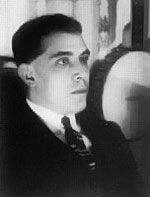(Madrid 1887 - Boulogne-sur-Seine 1927)
Juan José Victoriano González, better known as Juan Gris, was a Spanish painter and one of the main figures of Cubism.
Juan Gris represents the culmination of Cubism. He developed the movement in a combination of its different phases with a rigor, a perseverance and a coherence that even the pioneers of the tendency themselves were unaware of (Picasso and Braque).
He was last but one of 14 brothers, whose father was Castilian and whose mother was Andalusian. He obtained the Certificate of Secondary Education in Madrid and later, by imposition of his family, he entered the industrial school. His father, who was a wealthy trader, was ruined, and after his death, which was soon after, Gris gave up his studies in order to continue with his artistic vocation.
For a short time he was in the Fine-art School of San Fernando, where he attended, among others, to the classes of Moreno Carbonero. His first drawings were published in the magazines Madrid Cómico and Blanco y Negro. Those publications were followed by several others through the German painter Willy Geiger, who lived in Madrid and included Gris’ drawings in the German magazines Jugend and Simplicissimus. Those magazines were really representative of the “Modern Style” and its influence could be seen in the earlier drawings of Gris.
In 1906 he moved to Paris, where he lived in the famous Bateau-Lavoir with Picasso, who helped Gris with those years of real shortage. Picasso introduced him to the environment where Cubism was shaping. An environment frequented by Apollinaire, Max Jacob, André Salmon and Raynal among others. He drew for the French magazines L’assiette au beurre, Le charivari and Le cri de Paris, as well as for the Papitu from Barcelona. In 1910 he began to paint following the trend of the Analytic Cubism, although without arriving to the radical breaking down of the objects, which was typical from this phase of the tendency.
In 1912 he exhibited Portrait of Picasso (The Art Institute of Chicago) in the Salon Des Independents of Paris. He signed a contract with the art dealer Kahnweiler in which the exclusive rights of Gris’ artworks were transferred to him. In 1913 he lived in Céret, in the Pyrenees, with Picasso and the sculptor Manolo Hugué. During the following year, he lived in Collioure with Matisse and Marquet. He was there when the First World War began and after some months with Matisse, he went back to Paris. From 1915 to 1920 Léonce Rosenberg became his art dealer and from 1920 onwards he exhibited his works at the Galerie Simon in Paris.
Towards 1919 with the series of the Pierrots, a new phase of his career began. This new phase of the Synthetic Cubism would last until his death. In 1923, he worked for Diaghilev with the Ballets Russes and he made knitting patterns and ballet sets for several plays of this ballet. He illustrated some works by Reverdy, Max Jacob, Salacrou, Tristan Tzara and Radiguet.
In 1924 he delivered a lecture in the Sorbonne entitled “On the Possibilities of Painting”, in which he explained the method he had for working. Unlike Cézanne, his method lied in starting from abstract notions in terms of form and colour in order to get concrete figurative realities. He said: “Until now, the realization of a painting had an objective. My method is quite the opposite: it is not the painting coinciding with the object, but the object coinciding with the painting”. Due to his delicate health, Gris succumbed to tuberculosis and to a uraemia attack being at Boulogne-sur-Seine, where he lived since 1922.
His not very numerous works, due to his early death and the relatively short time of his full dedication to painting, are preserved in private European and American collections, as well as in several museums. There are 10 canvases in the Museum of Basel and among them all we find his works The Guitar, Fruit Bowl, Book and Newspaper, Guitar with Clarinet, Lemon and Strawberry Jam. Other artworks that are also preserved in museums are Still Life, Bottle And Fruit Dish (Kröller-Müller Museum, Otterlo); Violin and Glass, Breakfast, Still Life on a Chair, Pierrot and The Blue Cloth (Museum of Modern Art, Paris); Still Life in Front of the Window (Philadelphia); and Bottle and Fruit Bowl (Minneapolis).


